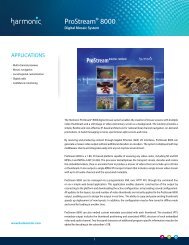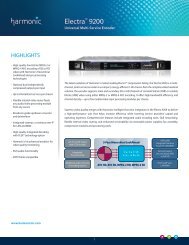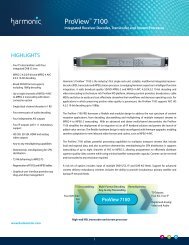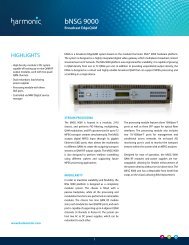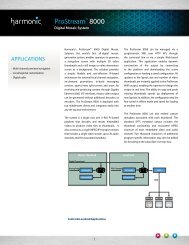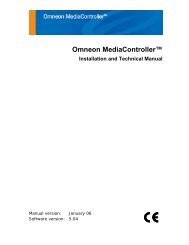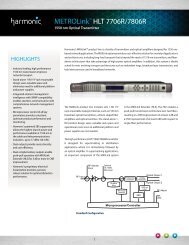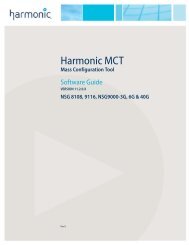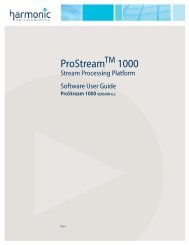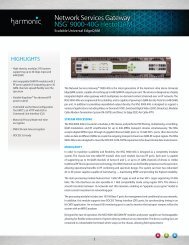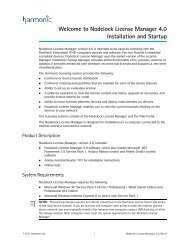NSG 9000-6G - Harmonic Inc
NSG 9000-6G - Harmonic Inc
NSG 9000-6G - Harmonic Inc
Create successful ePaper yourself
Turn your PDF publications into a flip-book with our unique Google optimized e-Paper software.
Chapter 4 Configuring Applications<br />
M-CMTS Application<br />
1. Select Applications > M-CMTS tab:<br />
Sessions appear in the table according to your QAM configuration in <br />
Platform > General > Slot > QAMs. Each session appears with a unique session ID.<br />
Session ID- Read only. A sequential number starting at 10000, to indicate the number of<br />
the session in the current page.<br />
NOTE: Steps 2&3 are relevant to primary DS channels only. In case of wideband sessions, move to step 4.<br />
2. Relevant to primary DS channels only - To synchronize with the DTI time, select DTI Sync<br />
Restamping. The EdgeQAM re-stamps the DTI sync packets.<br />
3. Relevant to primary DS channels only - In DOCSIS Sync Compensation, enter the sync<br />
compensation. The CMTS core router automatically inserts DOCSIS sync packets into the<br />
primary DS QAM channels. To ensure the accuracy of the DOCSIS sync packets, the<br />
EdgeQAM re-stamps them. Depending on RF network topology, it may be required to<br />
fine-tune the sync messages that flow over the various QAM channels of the EdgeQAM.<br />
The fine-tuning ensures consistent timing of CMs across all cable interfaces of the<br />
system. To fine-tune the sync offset across cable interfaces, use the DOCSIS Sync<br />
Compensation option. The sync offset units are ticks of the CMTS 10.24 MHz clock, where<br />
1 tick=97.6 nano-sec. The typical allowed offset difference between modems is +/- 6<br />
ticks. To define the sync compensation value, measure the average Cable Modem (CM)<br />
timing offset difference (you can view the timing offset values via the CMTS console) and<br />
calculate the desired compensation value for the QAMs of the port. Typically, the<br />
compensation value of adjacent QAMs in the port is identical for each QAM in the port.<br />
4. To select the input GbE Port, open the GbE Port list and select the required port. Once you<br />
defined the required GbE port, the GbE IP Address box is updated to display the IP address<br />
of the selected port.<br />
5. In GbE IP Address, enter the IP address of the GbE input port.<br />
6. In L2TP Session ID, enter the required session ID.<br />
7. View the following Read-only information:<br />
<br />
In RF Output, view the QAM channel to output the session where:<br />
X – module number (1…9)<br />
Y – RF port number (1…2)<br />
Z – channel number (1…144)<br />
QAM Index - see Configuring/Viewing QAM Channels on page 49.<br />
Interleaver - see Configuring/Viewing QAM Channels on page 49.<br />
© 2012 <strong>Harmonic</strong> <strong>Inc</strong>. 99 <strong>NSG</strong> <strong>9000</strong>-<strong>6G</strong>, Version 2.7, Rev B



